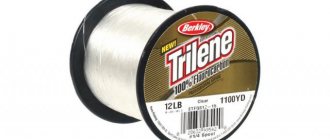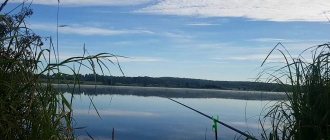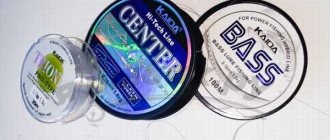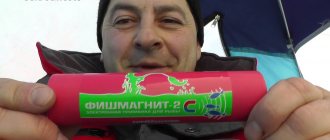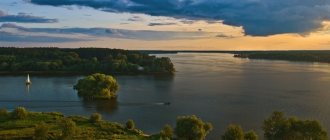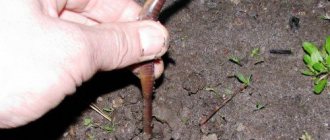It is very important for any fisherman to understand that fishing is not about the quantity and quality of the fish paraphernalia that he bought for fishing, but also about the quality and quantity of the fish caught.
There are times when even the most expensive spinning rod, and one of the expensive baits, lures. the fish doesn't want to bite. And then you need to figure out why.
Of course, there can be many factors, but one of the important factors is weather conditions. This is the reason we will talk about today.
The influence of weather on fish behavior while fishing
When the weather changes in a reservoir, absolutely everything changes: water temperature, speed and direction of current, wind on the surface, water lighting, water density. With all this, the behavior of the fish changes very dramatically.
When it gets cold or the water temperature rises strongly, she may lose her appetite and she may lie down in some depression at the bottom and not lick herself or even move at all.
At this time it is especially difficult to catch it; if it is still daytime outside, it is almost impossible. Although luck is such an elusive thing!
It is best to go fishing in bad weather either early in the morning or late in the evening. It is at this time that the fish begin to actively consume food and there is a possibility that it will bite your bait.
What should you take with you when fishing in rainy weather?
To feel comfortable on a rainy day, be sure to take a set of spare clothes, a raincoat and rubber boots. A good option is a suit consisting of a jacket and pants made of waterproof fabric. Dry spare clothes are needed if you are staying overnight.
A tent is a reliable protector from rain. Modern tents are made of waterproof fabrics and can be set up by one person. The best option is an automatic tent. It unfolds itself. You just need to do a few simple operations. You can easily install it in a minute.
If you are used to spending the night in a tent, be sure to take an air mattress or a small cot with you. A folding bed will be appropriate if you come fishing by car. The mattress takes up much less space. Very successful models that do not need to be inflated. This mattress unfolds, an air hole opens, and in 10 minutes it inflates itself. The height of the air layer is approximately 5 cm. This product is a successful substitute for a home bed.
There are also models with a pillow. This is perhaps the ideal option.
It is very important to take a sleeping bag with you. It will be comfortable even in wet weather. As for an umbrella, a beach umbrella with a large hat will do just fine. It fits in a case for medium-sized rods. There are umbrellas designed for fishing in rainy weather. They are a successful symbiosis of a tent and an umbrella.
As you can see, the angler is maximally protected from the rain and can wait for bites without feeling either the wind or drops falling from the sky. The only drawback is the sound from precipitation falling from above. But with a good bite, this nuance fades into the background.
For groceries, be sure to take a thermos with tea or coffee, or even better, a burner on which you can cook simple, tasty food and boil water for a hot drink. If you don’t want to cook, you can get by with sandwiches and soup in a thermos.
Another important attribute when fishing in bad weather is a fire source. It is better to have matches intended for camping conditions or several working lighters. You won't be able to light a fire. A gas burner with a cylinder is the best option for such conditions.
Water temperature
The behavior of fish, its activity towards food very much depends on weather conditions, namely on the temperature of the water in the body of water in which it lives. Water temperature changes with the frequency of changing seasons in nature.
Oxygen dissolves in water, but how much of it will be there depends on the temperature of the water. The higher the water temperature, the lower the amount of oxygen in it; if lower, then vice versa. Of course, if the water is very polluted, then the presence of oxygen in it is low.
If the depth of the reservoir is greater than its width, then in the middle of the depth of the reservoir there is a “thermocline” - this is when the water under no circumstances, below this line, warms up above 5 degrees Celsius.
Fish do not live under the thermocline, there is no vegetation there and oxygen does not reach there. She simply has nothing to eat there. Therefore, there is no point in throwing it deep there. Although now there are very few such reservoirs. Probably only Lake Baikal.
In warm water, the digestion of food by fish occurs much faster than the same process at a cold temperature of the reservoir. Therefore, as a result, it is better to catch fish in the warm months of the year than in the cold ones, but even in extreme heat, fish activity is low.
It is better to catch fish in the morning, because the surface of the water cools and sinks to the bottom. Even if the mercury column is high, it plays a small role.
For each fish there is an ideal temperature, for example for pike and bream it is 15-18 degrees; for crucian carp -18-20 degrees; for trout - 10-12 degrees; for carp 21-23 degrees.
How does rain affect fish habitat?
Rain performs two functions at once:
1. Affects the temperature of the water in the reservoir; 2. Saturates water with oxygen.
Water temperature
Fish, like other living beings, loves stability. Since fish are cold-blooded creatures, the ambient temperature affects its body temperature and the metabolic rate in the body.
There is a water temperature at which fish feel comfortable. This comfortable temperature may be different for each breed of fish. For example, carp feels good at 20 degrees Celsius, ruff at 12 degrees, and burbot feels ideal at 5 degrees.
If rain changes the water temperature, bringing it closer to the “ideal” temperature, then fish activity increases sharply. If rain, on the contrary, moves this temperature away from some “ideal”, you can’t expect a bite.
Oxygen
An increase in the percentage of oxygen in water definitely enhances metabolic processes in the body of any fish. The fish begins to feed more actively.
How does the bite change during rain? It is impossible to answer this question unequivocally without reference to:
- season;
- weather conditions preceding the rain.
Wind
When there is wind, the surface of the water is very saturated with oxygen and slowly, due to diffusion, saturation of all layers of the reservoir occurs. True, this process is very slow.
Fish, especially those living on the bottom, react very strongly to changes in wind. If the weather is windy or rainy or a cloudy day in the summer, then the activity of the fish increases noticeably.
This also happens during Indian summer. But if at this time the weather changes quickly, then the fish will not bite constantly. When the north wind blows, the fish bite stops.
Precipitation: the effect of rain on fish biting
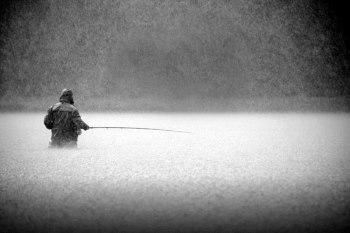
Rain also has a significant impact on fish activity. Many anglers have heard that when it rains, the fish bite improves. But everything is not so simple.
In the hot season , when the water is well warmed up, rain really helps the fish come to their senses. It cools the hot water a little and saturates it with oxygen. The fish becomes lighter and begins to feed more actively. Sometimes cool rain on a hot day even leads to active feeding of fish.
Even a little drizzling rain can activate passive fish, especially such weather has a good effect on the bite of predators - pike, perch, pike perch. But this is if it rains on hot days.
At a comfortable water temperature , light rain most often activates the fish and its bite improves. Only if it's just regular summer rain. Abnormal weather in the form of heavy winds, rain and hail will not be a positive thing for the fish. And few people will be able to fish in such conditions.
If the weather is frankly cold , then the rain will force the fish to give up searching for food. The fish now need sun and warmth, not rain. Another point is that prolonged rain is usually accompanied by a sharp drop in atmospheric pressure, which entails a deterioration in fish bite. But a little drizzling or pouring rain on a hot sunny day practically guarantees a good bite.
Atmosphere pressure
Atmospheric pressure changes several times throughout the day. But this does not particularly affect the activity of the fish. When atmospheric pressure changes, the density of water and its state change, so the fish is lost in space at some point.
But if the atmospheric pressure drops sharply, the fish will feel it and the bite will worsen, especially for bottom fish. When the mercury column rises, the fish go to the bottom, and when the pressure decreases, they rise closer to the surface of the water.
With a sharp increase in the mercury column, the fish bite becomes much more active, the bottom fish come closer to the shore, to the upper layers of the water. The larger the fish, the more painful it is to tolerate changes in mercury levels.
Pressure affects fish after 10 am. With increased pressure, activity increases in the following fish: bream, roach, silver bream, perch, and others. Predatory and bottom fish are not active at this moment. At low pressure, the following predatory fish are caught: catfish, pike perch, pike.
When does a fish stop biting?
Biting stops completely in the following cases:
- In summer:
- In complete calm and heat, especially on bodies of calm water;
- Before a strong thunderstorm;
- During a sudden change in atmospheric pressure;
- During periods when strong north or east winds blow;
- During periods of sudden changes in air and water temperatures;
- On mayfly departure days;
- On new moon and full moon;
- In winter:
- During periods associated with sudden changes in weather (similar to summer fishing);
- In the wilderness (associated with a lack of oxygen in the water)
How to determine what the weather will be like?
For fishing it is very important that the weather is good. Suddenly it didn’t rain or it was incredibly hot.
At the moment, in the modern world there are 3 ways to find out about the weather for the next few days:
- First way: Internet. You need to look at several sites to be sure of a particular weather forecast.
- The second way: the media - newspapers, magazines, television.
- And the third way: folk signs. All three methods may differ slightly and of course no one can give a 100% guarantee of what the weather will be like on the day you need. But you need to know at least approximately.
Signs of stable weather:
- The weather will be clear if the street is calm and quiet during the summer day, wavy clouds appear in the sky, gradually moving from the southeast, and disappear in the evening.
- If there is a rainbow, then this means good and clear weather.
- Swallows fly high - for clear weather.
- Seagulls land on the water.
- The lowlands are covered in fog at night.
- Bees fly out for a bribe early in the morning.
- The long branches of the fir trees are straightened.
Signs of unstable weather:
- Swallows fly low above the ground - predicts rain.
- If you see mosquitoes all day, it means rain.
- A red sunset means cool weather.
- If the barometer shows a decrease in atmospheric pressure, this means bad weather.
- A sharp drop in temperature
- Seagulls do not fly over water.
- The speed and direction of the wind changes sharply.
Cloudiness
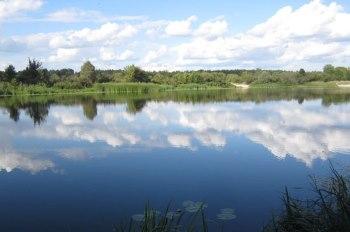
As you have noticed, some weather factors do not globally worsen or improve the fish bite, but act locally. That is, under certain conditions, fish will be better caught in a particular area of the reservoir. One of these factors is cloudiness.
Cloudiness can rarely lead to a decrease or increase in fish activity, unless it is caused by a sharp drop in pressure. But this factor should be taken into account when choosing a fishing location. Because, depending on the temperature and the presence of clouds in the sky, the fish may give preference to certain areas of the reservoir.
In hot weather, cloud cover can improve the bite intensity. If the reservoir is closed from direct sunlight, the fish will be able to get out of their hiding places and go to smaller areas. During the summer heat, cloud cover can play a positive role in fishing.
If, at high air and water temperatures, the sky is clear, the fish will stay at depth, under the crowns of trees or near underwater sources, in general, where coolness can be found. Lack of clouds in hot weather can reduce fish activity.
In cold weather, cloudiness can negatively affect the bite, as the fish now need the sun. In cold weather, fish usually do not come out of their hiding places. In cold temperatures, the bite improves as the sky clears. Then the fish strives for the warmest parts of the reservoir - in shallow water, and there you should try your luck.
Partly cloudy weather usually affects fish in such a way that in such weather they spend almost all their time at shallow depths and, in principle, continue to actively feed.
In what weather does fish bite better in spring?
Spring is one of the best times of the year for fishing. She was hungry after a long winter. The ice is melting, the water is becoming more and more saturated with oxygen, and the fish are also beginning to behave differently.
For successful fishing, the water temperature must rise above 10 degrees Celsius. The best weather for fishing in spring is cool weather with a light breeze, maybe a drizzle. Of course, if there is a strong wind, a storm, heavy rains, or a sharp cold snap, then the fish will stop biting again.
The influence of water transparency on the bite

Water transparency is a fairly important factor that can affect fish bite. It is important to know in which water the fish will bite better in order to clearly understand why the fishing was successful or, conversely, unsuccessful.
Clear water improves the fish's visibility, which means the fish are able to see your lure or bait from a greater distance. But, at the same time, the fish sees the fisherman better, which certainly affects the fishing activity and caution of the fish.
It is also worth noting that in clear water it is better for the predator to offer bait of natural or dull, dim colors. In clear water, the fish sees even nondescript baits perfectly, while baits of aggressive colors are more likely to alert it.
And so, we can conclude that clear water has positive aspects in that the fish can see your bait well. And the negative side is that the fish also sees the fisherman well, so when fishing a short distance from the shore, it is better to dress so that you blend in with the environment and the fish does not see you, otherwise the bites will be very careful or the fish will be completely afraid to take your bait.
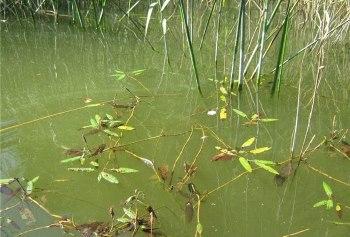
Cloudy water also has both pros and cons. But the pros far outweigh all the negatives. For example, peaceful fish easily find bait even in muddy water. But, even if the water has become completely opaque due to heavy rain or for some other reason, the problem can be solved by using white maggots or dough as bait. After all, a light-colored bait is more noticeable in muddy water, which will allow us to attract fish from longer distances.
When catching predators in muddy water, silver spoons or wobblers of poisonous colors perform well. Using baits of these colors will help you increase the number of bites precisely because the fish will see your bait better. In muddy water, it is difficult for a predator to notice an inconspicuous spoon or wobbler, so fishing efficiency can drop significantly if your bait is difficult to see.
A huge advantage of muddy water is that the fish takes the bait more confidently, it is not afraid of everything that happens above the surface of the water and it does not see the fisherman himself. The only downside is that the bait is less visible, but often other senses, such as smell or the lateral line, help the fish detect it.
Muddy water is the best water for fishing! In opaque but clear water, the fish feels safe, it is very comfortable in such conditions and it loses caution. In a pond with muddy water there is practically no lack of bite. There are people who believe that it is not the weather or pressure that is the main reason for the lack of bite, but the transparency of the water. And this is often confirmed by practice.
The best weather for pike fishing
To catch pike, a lot depends on the person - bait, the correct fishing location, the ability to catch pike. Also, a lot depends on the weather conditions when fishing for pike. Let's look at what factors pike fishing depends on.
The first factor is pressure.
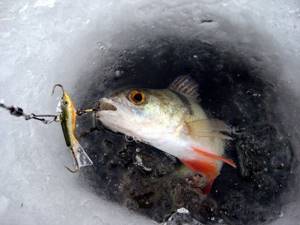
It is better to catch pike during the daytime. The readings of the mercury column also play a big role in this matter. For pike, like any other fish, it is ideal when the pressure is low.
At high pressure, fish activity is low. For a short period of time after a sharp decrease in atmospheric pressure, the fish bite is especially good.
They tolerate changes in the mercury column very poorly; it happens that the fish becomes completely passive towards food and stops moving.
The second factor is lighting.
You don't need bright light to catch pike. She doesn't love him. She also has a bad attitude towards the dark. Pike bite most actively in cloudy, calm weather.
The third factor is rain.
Light drizzle is ideal for pike fishing. The kind of rain that falls all day, fine and nasty - this is the ideal rain for pike activity.
The fourth factor is wind.
Quiet, windless weather is what pike need. Especially in the morning or when there is still fog over the pond.
Pike weather in winter
The pike bites until the ice hardens completely, that is, it becomes 5 cm deep, as long as there is a sufficient amount of oxygen in the reservoir. During severe frosts, the fish are passive.
Pike weather in spring
When the ice has melted and the water temperature has risen, the best period for pike fishing begins. In spring, when the water is enriched with oxygen, the best pike catch occurs.
Pike weather in summer
Pike does not tolerate heat very well when the atmospheric pressure is high, when the air temperature is high, so they bite in the summer months. Pike can actively peck only on thunderstorm days.
Pike weather in autumn
The best weather conditions for pike fishing in the fall are when there is a light breeze and drizzling rain for several days, preferably. The best month for pike fishing is September.
During Indian summer, fish activity is low. But the fact is that the water is no longer blooming, it has become transparent, and in such water the pike feels awkward. The pike bite is observed until the first frost, then the activity of the pike decreases slightly.
As we see, for a good bite, it is not enough to have good tackle, bait, bait; another important factor is weather conditions.
The most suitable weather for catching fish at any time of the year is not hot, with a temperature of no more than 25 degrees.
Let there be a light breeze, low atmospheric pressure, perhaps a quiet drizzle - these are the best weather conditions for fishing.
Should you go fishing if rain is forecast?
Before going fishing, you should check the weather forecast. Is there any point in planning this event if it's going to rain? It all depends on the nature of the rain, the pressure and the air temperature. For a better understanding, here are two different examples.
In the first case, we have a forecast that short-term rain with thunderstorms is expected in the middle of the day, but without significant cooling and with further clearing. This happens in the middle of summer. In the morning it feels stuffy and partly cloudy. After lunch, as predicted, it rained quite heavily. After it, the temperature dropped a little, there was no more heat and it became very fresh outside.
Naturally, underwater inhabitants react to such changes. The fish are biting more actively. The hooks are good, and the fishing itself is interesting and productive.
In this case, it’s definitely worth going fishing. It often happens that in warm weather, rainy weather gives way to sunny weather and fishing conditions become very comfortable. It’s not like sitting in the heat, then getting wet, waiting and thinking about finishing your fishing.
The second example is the opposite. It's September. A few days ago the weather was warm and calm. But for the weekend there is a noticeable deterioration in the weather with large amounts of precipitation. Is it worth going fishing in such a situation? Let's just say that if you are used to comfort and always count on catching fish, then it is better to postpone leaving for more favorable times. Those who are not afraid to be left with nothing in the cage and those who like to discover something new in fishing, who are not afraid of constant rain, dirty things and everything connected with it, can go.
How is fishing in such conditions? All standard actions should be done before the rain arrives. You definitely need to install a large umbrella that will protect you from the rain, and wear a waterproof suit or at least a jacket. It is also necessary to protect baits, groundbait and other accessories from rain. A film or oilcloth will definitely come in handy to cover all things.
You shouldn't count on catching a lot of fish. There is a high probability that it will rain at night. There is not much point in fishing at this time. If you came in a car, it is better to spend the night in it. If not, use a waterproof tent and an air mattress for one person.
You can count on the fish biting during small openings, when the rain stops and there is no gusty wind. At such moments you can catch some good white fish.
Thus, one should rely on good fishing during and after rain in cases where the pressure is not low and the rain is not associated with a cyclone in the summer. If the temperature drops noticeably and there is a cold and gusty wind, you should not expect a large number of bites.
A favorable factor for fishing in rainy weather is the presence of southern and western winds. Fishermen note that under such conditions the fish bite well on bottom and float rigs.
The influence of water level in a reservoir on the bite
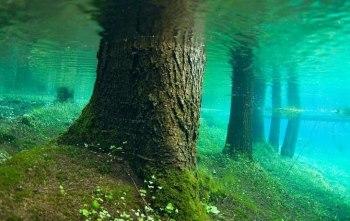
The water level also has a significant impact on the fish bite. A decrease or increase in water level in a reservoir has different effects on the behavior of fish and its activity.
If the water level in the reservoir decreases , then the fish loses activity and its biting may stop completely. In such situations, the fish tries to occupy the deepest places in the reservoir and stands in holes. Most likely, the fish is afraid that the water might go away completely, so it’s not interested in biting right now.
An increase in water level, on the contrary, has a beneficial effect on the bite. When the water rises in the pond, fishing can become very successful. Therefore, be sure to pay attention to the water level upon arrival at the reservoir. This factor can predict what kind of bite it will be today.
This is how weather conditions can affect the fish bite. I hope the site ryba4ok.ru helped you understand when the fish are caught best. Good luck to everyone and no tail, no scales.

